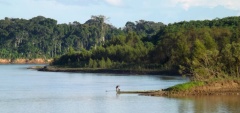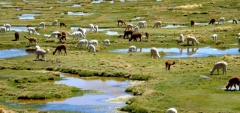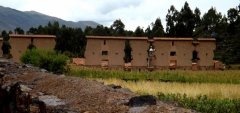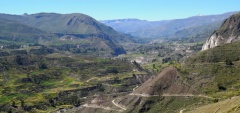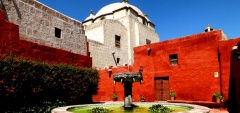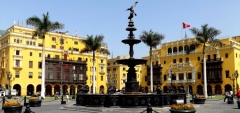What to see and do in Peru apart from Machu Picchu, Cusco and the Sacred Valley
In my first blog entry from my trip to Peru I went through my experiences in Cusco, Machu Picchu and the Sacred Valley, which is undoubtedly one of the major draws for those wanting to visit and plan a trip to Peru. However, there is definitely much more to take in on a holiday to Peru, from the high altiplano region and Lake Titicaca, to the peaceful valleys of the Colca Canyon and the vibrant wildlife of the Amazon Jungle, not to mention the thriving culinary scene in Lima.
On this trip, after taking in Machu Picchu and the Sacred Valley, I did a loop through Southern Peru, starting off at Puerto Maldonado, just a 35-minute flight from Cusco. Providing an entry point to the Tambopata National Reserve; it offers the opportunity to visit one of the last remaining easily accessible virgin tropical rainforests in the world and one of the most biodiverse in the Amazon basin.
I stayed at Inkaterra’s riverside Reserva Amazónica, which is a luxury eco-lodge on the banks of the Madre de Dios River, just a 45-minute boat ride downstream from Puerto Maldonado. Aside from being a great place to go and relax for a couple of days with excellent food and accommodation, the lodge runs tri-daily excursions into the jungle or along the river. Climbing up to the lodge’s canopy walkways we saw an array of different birds including flycatchers and tanagers, while canoeing on the nearby lake we were able to see a family of howler monkeys, a sleeping sloth, caiman and a group of curious-looking hoatzins or stink birds. For me, one of the best things about staying in the rainforest has to be the sounds that you hear and waking up to the sound of mockingbirds and toucans in the morning beats my alarm clock any day!
Returning from the humid Amazon rainforest, my next stop took me back to the Andes and the high altiplano region around Puno and Lake Titicaca. A huge contrast with where I had just come from, here very little grows and temperatures fall to as low as -25 at night in winter. Instead of taking the train, I took the Inka Express bus from Cusco to Puno, which takes 9 hours and stops along the way. A good opportunity to see sites and villages that you would otherwise miss, we visited the ancient temple of Raqchi and the Jesuit church of San Pedro Apostol at Andahuaylillas, otherwise known as the “Sistine Chapel of the Andes” for its exquisitely restored murals.
At Lake Titicaca, given the title of being the world’s highest-navigable lake, I stayed in Puno and visited the floating reed islands at Uros as well as the Quechua community at Taquile. This is a UNESCO- listed island, famous for its textile traditions, which date back centuries and require both men and women to learn how to weave intricate symbols from memory on pre-hispanic looms without patterns or drawings.
From Puno it was another 5 or 6 hour scenic bus ride over the altiplano to the Colca Canyon, famous for its condors and the spectacle of watching them soar as they search for food. Sitting at the side of the canyon waiting for the condors to appear I didn’t really know what to expect but to have them fly back and forth overhead on the hot air, which rises up from the canyon at certain times of the day, really was spectacular. Although most pass through Colca just to see the condors on their way from Arequipa to Puno, its peaceful valleys and green countryside make it a beautiful area for hiking, rafting and horse riding, or just relaxing for that matter!
Colca is a two and a half-hour journey from Arequipa, Peru’s second largest city. A Spanish-style city, Arequipa is dominated by its grand Cathedral and Plaza de Armas, as well as the colourful Convent of Santa Catalina. After spending two weeks in rural Peru it felt slightly strange to be back in what is a bustling student city, with lots of restaurants, shops and cafes. While I was there I was recommended to visit the Museum of the Mummy Juanita, who is thought to have been sacrificed by the Incas and was discovered over 500 years later in the crater of the Ampato Volcano. I would strongly recommend paying the museum a visit as well as the Iglesia de la Compañía and San Ignacio Chapel, whose walls and ceilings are covered in paintings depicting the Amazon Rainforest.
The final stop on my trip before flying home was the capital city of Lima, which lots of people avoid by connecting directly onto a flight to Cusco without leaving the airport. Once you get past the hair-raising traffic, Lima is a great city with a huge amount to see and do. In addition to its museums, such as the Museo de la Nación and the Museo Larco with its collection of Pre-Inca and Inca pottery, textiles and jewellery, which help to bring more of Peru’s history to life, Lima has surged into being the gastronomic capital of South America. With fresh fish and seafood from the Pacific, Lima is overflowing with ceviche restaurants as well as a huge range of other culinary offerings, including Japanese-Peruvian fusion cuisine, creole cooking and classic Peruvian cuisine. In fact, there’s so much on offer it deserves its own blog entry so you'll have to read our special foodie blog on Peru for more info!

